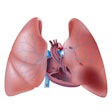Tuesday, November 28 | 3:20 p.m.-3:30 p.m. | SSJ22-03 | Room S403B
In this presentation, researchers will share how precise organ doses from lung cancer screening with tube current-modulated low-dose CT scans can be effectively estimated using simulation techniques.Currently, many radiologists estimate organ radiation dose using results from the National Lung Screening Trial (NLST), which determined organ dose based on fixed tube current simulations.
"An important shortcoming of this model is that the vast majority of clinical CT procedures, including lung cancer screening, are done with some form of automatic exposure control such as tube current modulation (TCM)," Anthony Hardy told AuntMinnie.com.
Using Monte Carlo simulation methods, researchers from the University of California, Los Angeles estimated radiation dose in the lungs of 26 patients following a low-dose CT screening protocol that used tube current modulation. This enabled them to predict the radiation doses that reached the lung and breast after low-dose CT scanning.
"Future predictive models for estimating patient dose should take into consideration not only the effects of TCM and, hence, patient size but also the effects of machine limits in terms of tube current output and the effects of user-specified scanning parameters," Hardy said. "All of these different factors and their associated effects coalesce to form a complex narrative in terms of our ability to estimate patient dose from CT procedures."



















